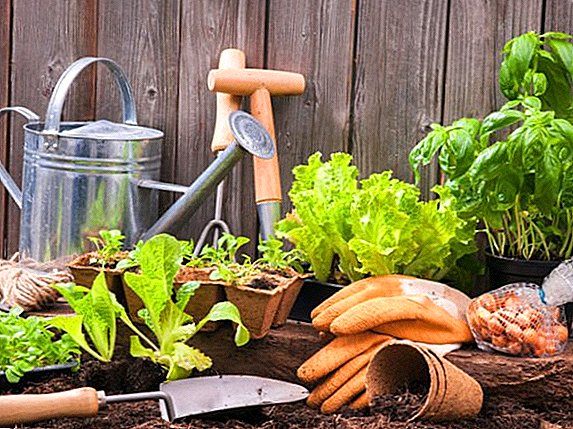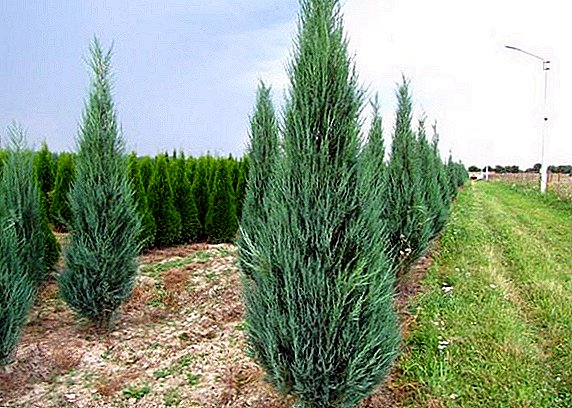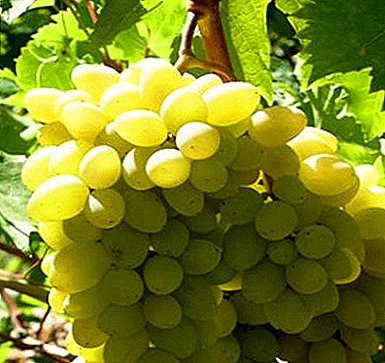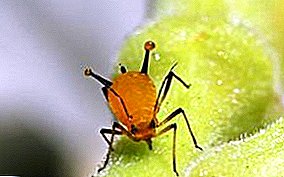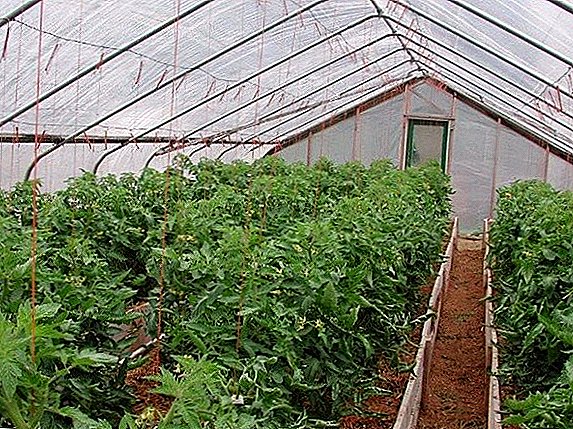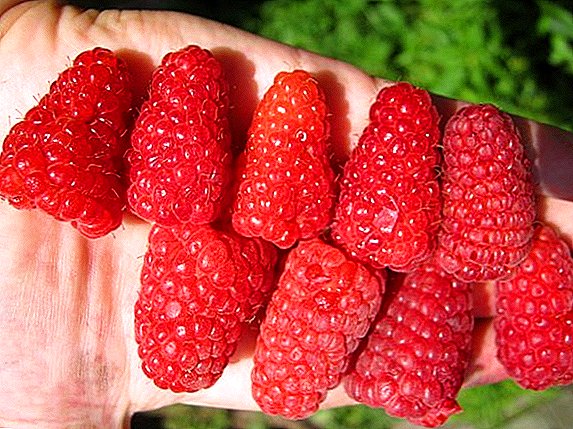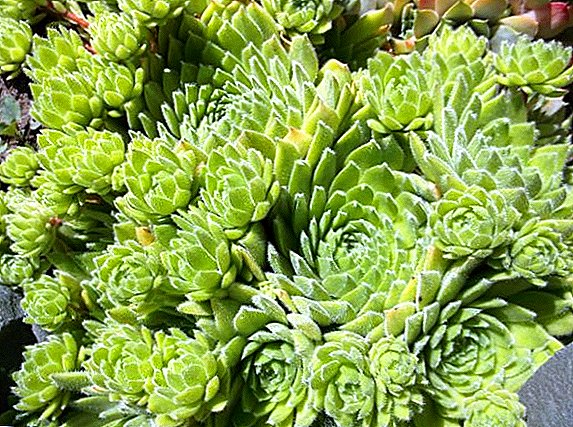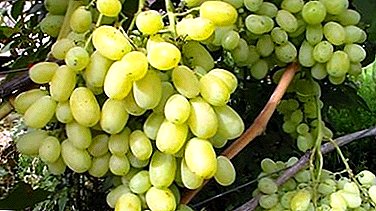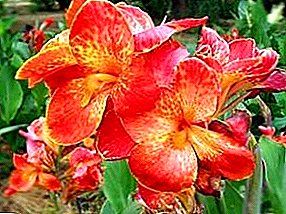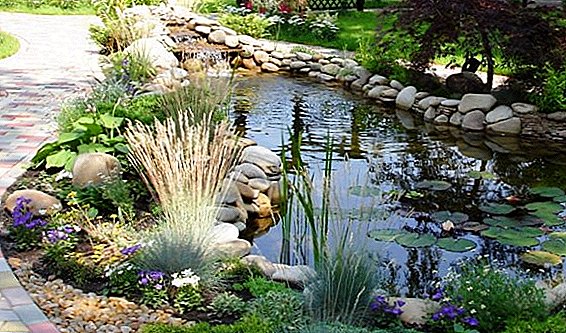 In a private house or in the country, many build artificial reservoirs. Of course, in this case you can not do without cultures that will be a wonderful decoration of the building. In this article we will describe which aquatic plants are more suitable for ponds and other bodies of water, how to plant and care for them.
In a private house or in the country, many build artificial reservoirs. Of course, in this case you can not do without cultures that will be a wonderful decoration of the building. In this article we will describe which aquatic plants are more suitable for ponds and other bodies of water, how to plant and care for them.
The role of plants in the pond
Undoubtedly, the cultures growing in the reservoir, make it more beautiful, original and alive.
Important! When arranging a reservoir located in a valley, it is very important to plant the plants around the perimeter in order to block the entry of thawed and rainwater into the pond.
 A variety of species and varieties allows you to create a beautiful landscape that will not be worse than in a natural pond. However, besides the decorative function, aquatic cultures perform other important tasks, namely:
A variety of species and varieties allows you to create a beautiful landscape that will not be worse than in a natural pond. However, besides the decorative function, aquatic cultures perform other important tasks, namely:- do not allow organic nutrient residues and fertilizers to get into the pond;
- saturate the water with oxygen during the daytime;
- create a shadow on the surface of the water, which helps to prevent excessive overheating of water in the summer;
- participate in the development of populations of beneficial bacteria;
- reduce the amount of nitrates in the water.
 If you want the pond to always be clean, be the decoration of your site, you must definitely have special plants in it.
If you want the pond to always be clean, be the decoration of your site, you must definitely have special plants in it.How to choose the right culture for the pond?
Virtually all types of aquatic cultures are suitable for growing in both natural and artificial environment. Consider what types of plants can be used for the reservoir in the country.
Water
This group differs from other plants in that the leaves are on the surface of the water. In this case, the root system is fixed in the soil. This type of vegetation serves as protection for the water surface and thickness from overheating., uses organic compounds, which prevents the process of "flowering" of water.  They grow quite quickly, so it is very important to take care of them carefully and in time: regularly cut and remove unnecessary shoots. If you use for growing special floating baskets, you can achieve a good result.
They grow quite quickly, so it is very important to take care of them carefully and in time: regularly cut and remove unnecessary shoots. If you use for growing special floating baskets, you can achieve a good result.
Deep water
These plants have a root system located in the bottom soil. The leaves are on the water, on top of them are beautiful flowers. Certain groups of deep-sea plants help purify water. The absence of such crops can cause uncontrolled reproduction of algae and bacteria. By the deepwater include swamp flower, water lily, yellow lump, vodokras, duckweed. 
Near-water
Cultures near the water are also very popular. They harmoniously complement the water composition and coastal areas.
Did you know? The seeds of water lilies are suitable for human consumption: having fried them, they brew a drink, the taste of which resembles coffee.
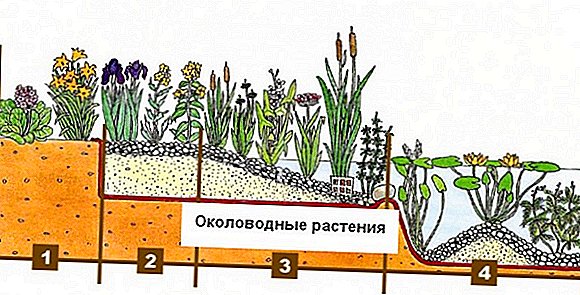 To create a picturesque view, cereal crops are often used; a flowering day-lily and iris, a bathing ground, a groundwort and valerian will also look great. The elegance of the pond will add fern.
To create a picturesque view, cereal crops are often used; a flowering day-lily and iris, a bathing ground, a groundwort and valerian will also look great. The elegance of the pond will add fern.The adjacent zone is located in close proximity to the coast. Plants growing in this area can serve as a living barrier against the ingress of water from the outside into the reservoir. It grows well here: host, daylily, badan, astilba, rhubarb, primrose.
Marshlands
This type of aquatic plants is quite unpretentious, so it can be planted both in the sun and in the shade. An important point in the care of marsh crops is regular seating, as they grow very quickly and can spoil the attractive appearance of the oasis. You can plant such plants for the pond in the country: Magellan sedge, marsh violet, Marsh forget-me-not. 
Oxygenators
These are, perhaps, the most useful from the ecological side perennials, characterized by the fact that most of the culture is located under water, and its flowers are mostly on the surface.  Oxygenators prevent water pollution, are food and breeding grounds for some species of fish.
Oxygenators prevent water pollution, are food and breeding grounds for some species of fish. 
Landing rules
Depending on the type of plant, there are several ways of planting. Consider each one of them.
In open ground
To create a composition that is as close as possible to the natural landscape, the planting of plants is carried out in the soil of water bodies. On the pre-selected area you need to lay out 20-30 cm of the substrate. From above it is necessary to cover it with a thin layer of gravel, which will prevent the substrate from floating up at the moment of filling the pond with water.
Important! Plants should be planted only in heated and settled water (about 10 days). Otherwise cultures will not take root and will die quickly.If you do not want to completely fill the reservoir with soil, you can create landing holes and lay out a layer of substrate in them. Pitches half a square meter with a depth of 40 cm is enough even for expanding water lilies. The main advantage of using landing pits is related to the process of removing unwanted shoots and parts of rhizome - in a limited area it is much easier to do than to unravel woven roots that occupied the entire bottom of the pond.
In containers
Plastic containers, as well as small pots, create 3 serious problems: lack of stability, lack of nutrients and restriction of the natural development of crops.  When planting tall plants in a container, stability must necessarily be ensured. For such cultures, wide but not too high containers are ideal. To increase stability, you can strengthen the capacity of stones located on the surface of the earth in a pot. You can also use weighting agents at the bottom of the tank.
When planting tall plants in a container, stability must necessarily be ensured. For such cultures, wide but not too high containers are ideal. To increase stability, you can strengthen the capacity of stones located on the surface of the earth in a pot. You can also use weighting agents at the bottom of the tank.
If landing is planned in the coastal zone, the container can be attached to the shore. Plants quickly absorb nutrients from the substrate, so you need to regularly feed. It is also recommended to make a hole in the bottom, which will facilitate the absorption of water. But, unfortunately, through them the roots can penetrate into the reservoir itself. Landing in containers has a lot of drawbacks, so if you can, you should give it up.
In water
This method of planting involves the immersion of plants in a pond. The root system, leaves and stems will be constantly in the water and free to float. Unfortunately, such cultures die when the temperature of water and air decreases, so before the onset of winter cold they should be removed from the reservoir, and with the arrival of spring, they should be planted again. 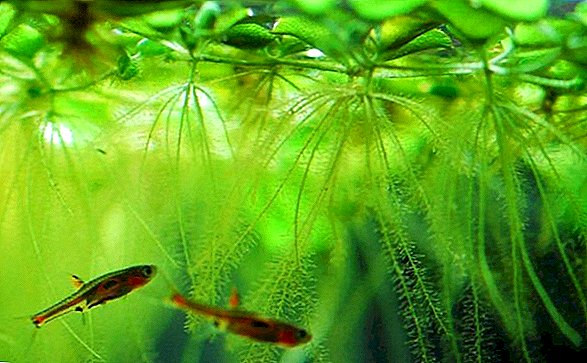
General care tips
Water plants for the pond need care. The availability of a cleaning system makes it much easier to maintain an artificial pond - in this case, it is worthwhile to periodically cut off excess shoots, roots and algae. If you decide to equip an artificial reservoir on the site, we recommend that you take into account the following tips:
- In the reservoir, which has a small size, more likely to "bloom" and cloud water.
Did you know? The lotus is one of the few plants that can grow for over 1000 years and has the ability to regenerate after a long rest.
- To remove unnecessary vegetation from the surface, a net, rake, or special forceps will do. You can also cut off dead leaves and other plants with scissors that have a long telescopic handle.
- With the advent of cold, you need to cut buds from floating crops and place them in a jar until spring. If the plant does not possess frost resistance, it is necessary to move it to more comfortable, warm conditions for the winter.
- In the care should regularly remove the duckweed. It is also necessary to cut flowers that are already dead.

Features of the design of reservoirs
In order to equip a beautiful water oasis, it is important to follow some tips. Consider how and what plants it is better to issue reservoirs of different species.
Large
If you decide to equip a large reservoir on the site, you should follow certain rules:
- First you need to make a project. A large area will create an original, beautiful natural composition.
- Reservoirs, whose depth is more than 1 m, have a stable ecosystem, compared with shallow ponds. Despite the size, caring for a large body of water is easier.
- If you have a large territory at your disposal, you can use boxwood, ephedra and rhododendrons to create the background.
- Badan, lysikhitron and funky will look harmoniously next to large bodies of water.
- In the pond, small islands surrounded by moderate reed thickets will look great.
- On the surface of the water can be placed nymphs and lotuses.
In a large pond, a culture such as water-nut Chilim will take root well. In addition to the beautiful appearance, it has fruit, suitable for use.
Little ones
Having a small oasis of water will transform your site. A small body of water can be home to such living creatures as tritons, frogs and water striders. 
Important! With the arrival of spring, it is imperative to replace at least one fourth of the water in the reservoir in order to provide the plants and fish with a healthy atmosphere for normal development.
When choosing a crop for planting in a small pond, it is important to pay attention to its rate of growth. Plants rapidly covering the surface of the water can transform a beautiful body of water into a swamp.
Choose plants that float on the surface with small leaves. Ideal water hyacinth, decorative water lily. On the shore, you can plant ordinary particles, an ordinary cuff, a forget-me-not marsh and a river gravilat. If you like higher cultures, bamboo, sedge, foxglove will do.
Geometric
Geometric ponds look perfect in classic-style homes. The form of an artificial pond can be different: square, rectangular, round. High walls are usually built around it.  For such a structure you need to choose a culture that will emphasize its geometry. For edging suitable trimmed boxwood, umbrella susak, ivy. You can decorate the surface of the water with lotuses, water lilies. On the shore will look beautiful curly roses and daylilies.
For such a structure you need to choose a culture that will emphasize its geometry. For edging suitable trimmed boxwood, umbrella susak, ivy. You can decorate the surface of the water with lotuses, water lilies. On the shore will look beautiful curly roses and daylilies.
Fountains
As a rule, the size of such bodies of water is not very large. It is recommended to plant no more than three types of small plants. Sedge, iris and arrowhead will look great on a high level. At the lower level, it is better to land a cattail, cuff and sabelnik. In the center you can place a pistia or a decorative nymph. 
Brooks
For the construction of the channel is better to use stones and pebbles. Among the plants, you should choose weeping species: decorative larch, cedar, French willow. On the shore, you can land dicenters, miniature irises, hvoyniki. In brooks you can grow algae.
Did you know? Lemna is one of the aquatic plants that breaks all breeding records: about 33,000 leaves can appear from 1 leaf in 30 days

To create a mountain stream you need to choose a place with a slope. On the banks will look beautiful flowering bushes. It is recommended to place a swamp forget-me-not, dwarf sedge on the water surface. At the very bottom of the stream, you will need to build a small container into which water will flow.
By building on the site of an artificial reservoir and the colonization of its plants should be approached seriously. However, the result will be worth it, and you can enjoy the magical beauty of your own water oasis.


